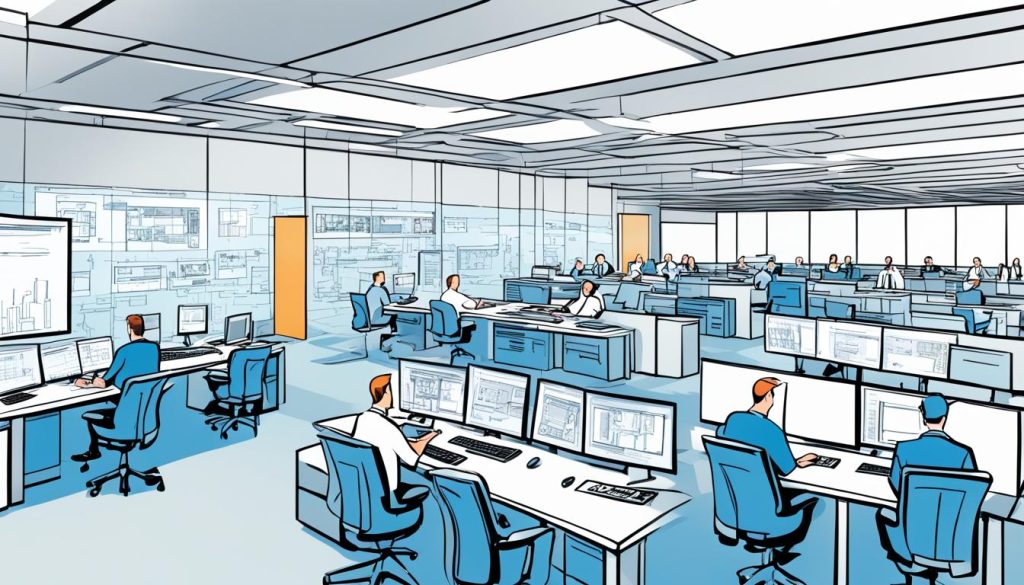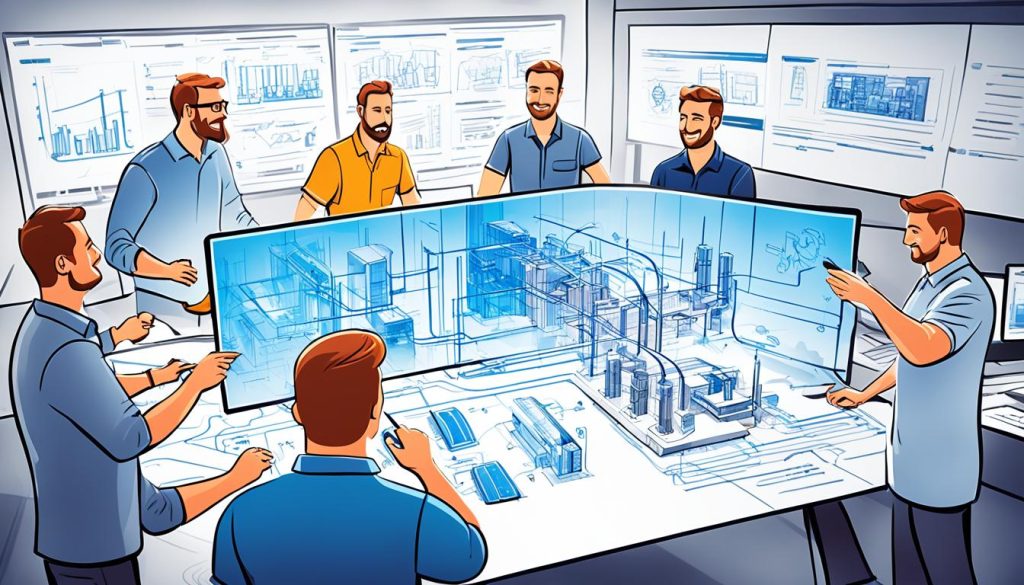You can make CAD HVAC software work better with Building Information Modeling (BIM) by following a step-by-step plan. This mix brings CAD’s precision and BIM’s data management together. It makes HVAC design coordination smoother and speeds up project delivery.
Start by learning what your HVAC software and BIM platform can do. Make sure they work well together, often using file formats like IFC or plugins. By combining these tools, you get a workflow that updates in real-time, spots clashes, and supports teamwork in design.
To get the most out of this blend, set up clear rules for sharing data and coordinating models. Train your team to use this new setup well. Teach them the value of correct data and keeping models up-to-date. With the right approach, you’ll see better project coordination, fewer mistakes, and a smoother design process.
Understanding CAD HVAC Software and BIM: A Primer
CAD HVAC software and Building Information Modeling (BIM) are changing how we design and manage mechanical systems. This primer looks at these technologies and their effect on making projects more efficient.
Defining CAD HVAC Software
CAD HVAC software is a tool for designing mechanical systems. It lets engineers make detailed ductwork designs and improve airflow in buildings. This software makes complex structures more accurate and boosts system performance.
Exploring Building Information Modeling (BIM)
BIM is a way to work together on building design and management. It makes a digital model of a building’s look and how it works. BIM puts together different building systems, like HVAC, into one model. This helps with better decisions during the project.
The Intersection of CAD and BIM in HVAC Design
Using CAD HVAC software and BIM together brings big benefits to HVAC design:
- Enhanced coordination between disciplines
- Improved clash detection and resolution
- Optimized energy efficiency
- Better visualization of airflow dynamics
- Creation of sustainable systems
This mix supports interoperability standards, making data sharing between software easy. This leads to a smoother project delivery process, less rework, and better results.
| Feature | CAD HVAC Software | BIM | Integrated Approach |
|---|---|---|---|
| Focus | HVAC system design | Whole building model | Comprehensive design |
| Data Management | HVAC-specific data | Multi-disciplinary data | Integrated data flow |
| Collaboration | Limited | Extensive | Enhanced teamwork |
| Clash Detection | Basic | Advanced | Optimized resolution |
| Project Efficiency | Moderate | High | Maximized |
The Benefits of Integrating CAD HVAC Software with BIM
Combining CAD HVAC software with Building Information Modeling (BIM) has many benefits for your projects. This powerful mix makes your designs more accurate, efficient, and collaborative.
Model Synchronization is a big plus of this combo. Your HVAC designs stay in sync with the building model, cutting down on mistakes. This means everyone gets updates in real-time, across all parts of the project.
When CAD HVAC software and BIM work together, teams can collaborate better. They share data and insights across different areas. This leads to better communication and decisions among architects, engineers, and contractors.
- Improved spatial planning
- Enhanced conflict resolution
- Streamlined design process
- Data-driven decision-making
- Optimized energy consumption
With this approach, HVAC Design Coordination gets better. You can spot and fix clashes between HVAC systems and other parts of the building easily. This saves time and money, and makes the project run smoother.
This integration also helps with sustainability by letting you simulate and analyze performance. You can design HVAC systems to be more efficient, saving energy and cutting costs over time.
| Benefit | Impact |
|---|---|
| Improved accuracy | Reduces errors by up to 40% |
| Enhanced collaboration | Increases team productivity by 25% |
| Faster design process | Reduces project timeline by 20% |
| Better energy efficiency | Lowers building energy costs by 15% |
By using CAD HVAC software with BIM, you get a powerful tool for better HVAC designs. This combo leads to more efficient, accurate, and collaborative projects. It helps your projects succeed and ensures buildings perform well.
Key Features of CAD HVAC Software for BIM Integration
CAD HVAC software for BIM integration has key features that make projects run smoother and more efficiently. These tools help in making the design process better and help teams work together better. Let’s look at what makes this integration work.
3D Modeling Capabilities
Advanced 3D modeling is key for making detailed HVAC systems in building models. This lets you see complex mechanical systems and how they fit with other parts of the building. With 3D modeling, you can:
- Create accurate representations of HVAC equipment
- Design ductwork and piping layouts
- Perform spatial coordination checks
Interoperability Standards
Interoperability standards help data move smoothly between different software. These standards are key for working together and keeping models in sync. Common standards include:
- IFC (Industry Foundation Classes)
- gbXML (Green Building XML)
- COBie (Construction Operations Building Information Exchange)
Data Exchange Formats
Strong data exchange formats make sharing information easy among team members. These formats help CAD HVAC software and BIM platforms talk to each other. Popular formats include:
| Format | Description | Use Case |
|---|---|---|
| DWG | Native AutoCAD format | 2D and 3D drawing exchange |
| RVT | Native Revit format | BIM model exchange |
| DXF | Drawing Exchange Format | Cross-platform compatibility |
Using these features, you can model mechanical systems well, follow interoperability standards, and keep models in sync. This makes your HVAC design process more efficient.
Steps to Integrate CAD HVAC Software with BIM for Improved Project Coordination
Integrating CAD HVAC software with BIM can make projects run smoother. It takes careful planning and execution for a smooth CAD-BIM integration. Here’s a step-by-step guide to help you make this transition and improve your design workflows.

First, pick software that supports both CAD and BIM. Look for tools that make data exchange and model updates easy. This is key for a strong start to your integrated workflow.
Then, set up workflows that link CAD and BIM processes. Make sure everyone knows how to share data and update models. This keeps your team on the same page and cuts down on mistakes.
- Evaluate your current software and identify integration needs
- Choose compatible CAD HVAC and BIM software
- Establish standardized workflows and data exchange protocols
- Train team members on integrated processes
- Implement quality control measures
Training your team is crucial for CAD-BIM success. Offer comprehensive training that covers technical skills and new workflows. This helps your team adjust and use the new tools to their fullest.
Finally, put in place strong quality control to keep things consistent and fix problems fast. Regular meetings and virtual walkthroughs can spot and fix issues early. This boosts project efficiency even more.
Overcoming Challenges in CAD-BIM Integration for HVAC Systems
Integrating CAD HVAC software with BIM has its challenges. These include technical issues, changes in workflow, and the need for new skills. By tackling these challenges, you can make projects more efficient and improve how teams work together.
Technical Hurdles
One big challenge is making sure different software systems work together. This can lead to data loss or mistakes. But, using common data formats like IFC can help. These formats make it easier for CAD and BIM systems to share information.
Workflow Adjustments
Adding CAD HVAC software to BIM means changing how teams work. They need to learn new processes that fit both CAD and BIM. This might mean changing project phases, roles, and how teams talk to each other. Having good teamwork is key to making this work.
Training and Skill Development
Switching to CAD-BIM systems requires new skills. HVAC designers need to get up to speed on BIM, and BIM experts need to know HVAC design well. Training programs are important to help teams adapt and work more efficiently.
| Challenge | Solution | Impact on Efficiency |
|---|---|---|
| Software Compatibility | Implement interoperability standards | Reduces data loss, improves coordination |
| Workflow Changes | Establish new collaborative processes | Enhances team communication, streamlines design |
| Skill Gaps | Provide comprehensive training | Increases productivity, reduces errors |
By solving these challenges, you can fully use the benefits of CAD-BIM systems in HVAC design. This integration leads to better project results, better teamwork, and more efficient HVAC system design and setup.
Best Practices for Collaborative Design Workflows in Integrated HVAC Projects
Collaborative design workflows are key for successful HVAC projects. They help improve project efficiency and make the integration process smoother. Let’s look at some strategies to boost your team’s collaboration.

Good communication is the base of teamwork. Have regular meetings to talk about project updates, spot problems, and come up with solutions. These meetings can happen online, so everyone can join in.
It’s important to know who does what in HVAC design coordination. Make a detailed list that shows each team member’s tasks and what they’re good at. This avoids duplicated work and makes sure the project covers everything.
Use cloud-based tools for sharing info in real-time. These platforms let team members see the latest updates, make changes, and track progress easily. They also help keep track of versions, so everyone works with the newest files.
| Best Practice | Benefits | Implementation Tips |
|---|---|---|
| Standardized Naming Conventions | Improved file organization and searchability | Create a project-specific naming guide and train team members |
| Virtual Design Reviews | Early issue identification and resolution | Schedule regular review sessions with screen sharing capabilities |
| Continuous Improvement Culture | Enhanced innovation and efficiency | Encourage feedback and implement lessons learned in future projects |
Using these collaborative design workflows will make HVAC design coordination smoother and improve project efficiency. Adapt these practices to fit your project and team for the best results.
Enhancing Clash Detection and Resolution with Integrated CAD-BIM Systems
Integrated CAD-BIM systems change the game in HVAC design coordination. They make clash detection and resolution smoother. This combo helps spot and fix conflicts early, saving time and money.
Automated Clash Detection Processes
These systems automatically find clashes between HVAC parts and other building elements. They scan 3D models to highlight issues like ductwork hitting structural beams. This way, you avoid costly problems later on.
Real-time Conflict Resolution Strategies
Model Synchronization means updates happen in real-time across all teams. When clashes pop up, you can tweak designs right away. This keeps your HVAC design in line with other building elements, cutting down on rework and boosting accuracy.
Coordination Meetings and Virtual Walkthroughs
Virtual walkthroughs change how we coordinate HVAC designs. Teams can dive into the 3D model together, find issues, and make joint decisions. These sessions boost communication and help solve conflicts quickly.
| Feature | Benefit | Impact on HVAC Design |
|---|---|---|
| Automated Clash Detection | Early conflict identification | Reduces on-site rework |
| Real-time Model Synchronization | Instant updates across disciplines | Improves design accuracy |
| Virtual Walkthroughs | Enhanced team collaboration | Facilitates efficient problem-solving |
Using these CAD-BIM tools, you’ll make your HVAC design process better. You’ll cut down on mistakes and boost project coordination.
Leveraging BIM for HVAC Performance Simulation and Analysis
Building Information Modeling (BIM) changes the game for HVAC design. It lets you simulate your HVAC system’s performance before it’s even installed. This way, you can make sure your design is perfect for efficiency and comfort.
With BIM and energy modeling tools, you get deep insights. You can accurately predict energy use and carbon emissions. This info helps you make choices that save money and are better for the planet. It’s a big win for making projects more efficient.
BIM also offers advanced features like computational fluid dynamics (CFD) simulations. These tools show you how air moves and where it’s not reaching. You can fix problems early and make your HVAC system work better.
Using BIM isn’t just for design. The data from your simulations helps with managing the building later on. This smart planning leads to better results for building owners and people living or working there.





0 Comments